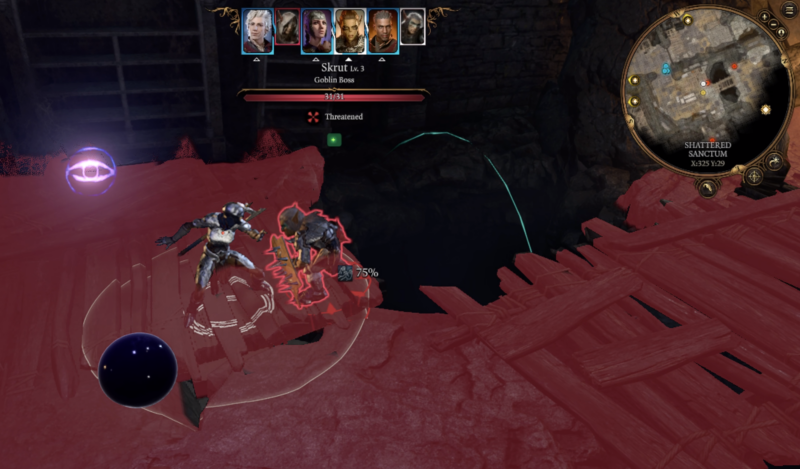
I had done a fair amount of optional grinding by my 25th hour of Baldur's Gate 3, My Githyanki warrior, Lae'zel, was leveled and geared up enough to be mostly one-shot-ing any goblins or wildlife that tried her, and quickly incapacitating even bigger threats. I was growing concerned that I was leaning on her a bit too heavily, not exploring the deeper tactical offerings of BG3's combat.
"Ha!" the game retorted. "Ha, ha!" That's what it sounded like to me, anyway. Lae'zel led the charge into the last decrepit corner I had yet to explore inside the goblin camp, eager to take out the third and final leader of the tribe. After ending her turn on a wooden bridge, a nearby goblin boss, Skrut, ran toward her. I wasn't concerned until, a few seconds later, the action log in the lower-right corner delivered the news: "Lae'zel perished in a chasm."
Skrut had leaned into something I had forgotten about since BG3 first introduced it: the Shove action. It was initially suggested as a way to get a character out of your melee range. If you shoved an enemy and it landed a long way down, they may even take damage and end up lying prone and vulnerable. But now I understood why the game showed you the text "Chasm" when you moused over a seemingly endless pit, the kind drawn into many games for pure environment. You can't click to walk your characters into a chasm, but they sure can be pushed into one.
Like most other things that happen in BG3, there's dice rolling going on behind "Shove." The game tells you that you, or some brutally efficient goblin boss, has passed an Athletics check to shove an enemy (or, in the right circumstances, maybe a friend). In the Baldur's Gate 3 subreddit, TalonIsMyDDName suggests there's a good bit more: your Strength-derived Athletics rolling against the opponent's Athletics or Acrobatics, whichever is greater, for a distance determined by your strength minus their weight. As the poster notes—and which I have learned—the shover's weight and size do not matter, just their athletics and strength at that moment.
Shove is part of the D&D Fifth Edition rule set, the same one BG3 uses (Baldur's Gate II used second edition rules). DND Lounge's shove explainer notes it as "tricky for first-time players to wrap their heads around." Shove can push an enemy outside the range where they get an opportunity attack if you try to run. Shove can, as noted, boop someone off a ledge to their demise. It can set up chain attacks, perhaps moving an enemy into an archer's range or force an opponent to use movement and actions to regain their ground. It's not explicitly an attack, but it can replace an attack action. You can technically shove twice in one turn. As something you argue out over a table, it's quirky.
In my first impressions of BG3, I tried to capture the game's alchemical mix of Dungeons & Dragons' limitless imagination with Divinity: Original Sin's exacting combat systems. I should have just mentioned Shove. Shove is one of those things that you wouldn't use primarily, or even secondarily, in a tabletop session. But it makes more sense in BG3, and it makes the game feel capable of anything, even when that "anything" makes you lurch to the loading screen.
So few games make you feel like you're on truly even footing with your computer opponents. You really are in BG3, so you'd better watch that footing.
Listing image by Larian Studios
Article From & Read More ( The “Shove” mechanic in Baldur's Gate 3 can ruin an encounter, and I love it - Ars Technica )https://ift.tt/fXKMwoQ
Technology
No comments:
Post a Comment